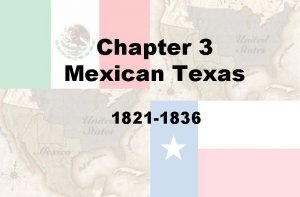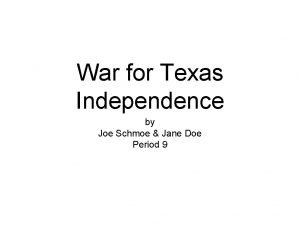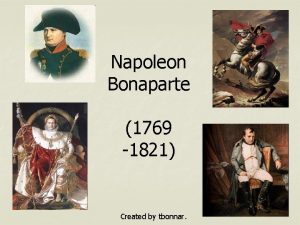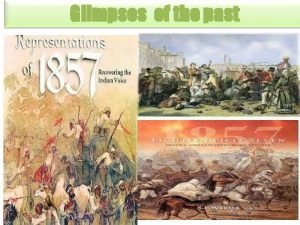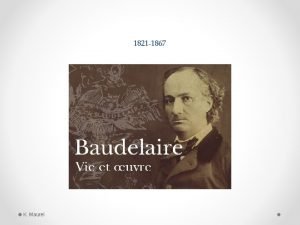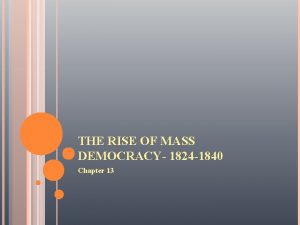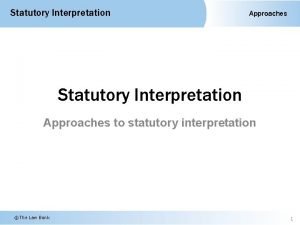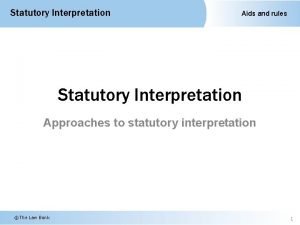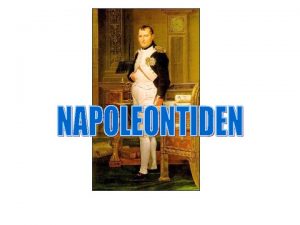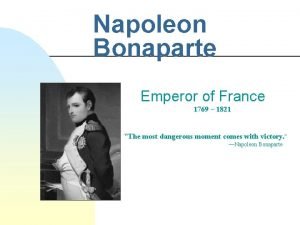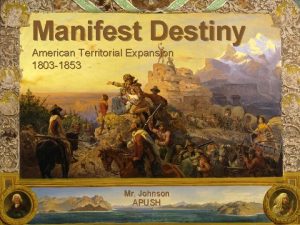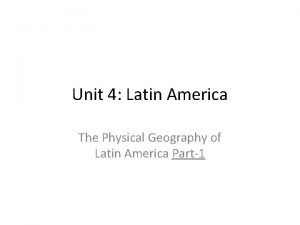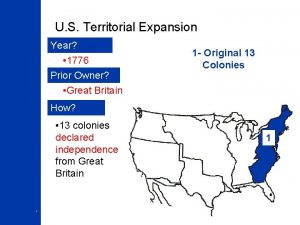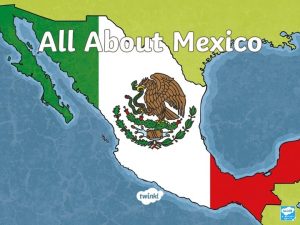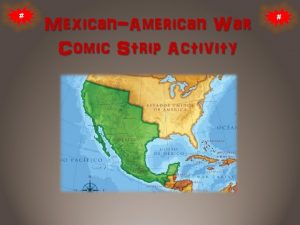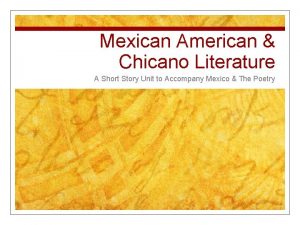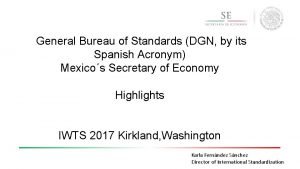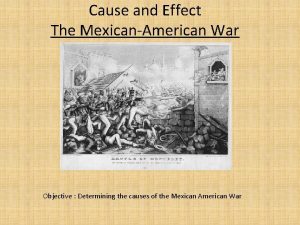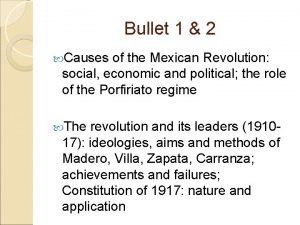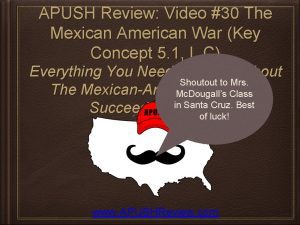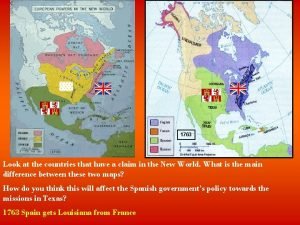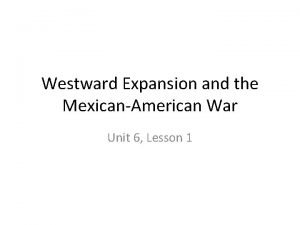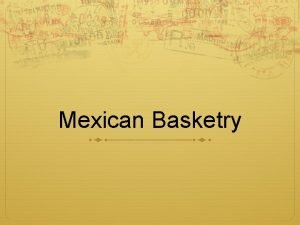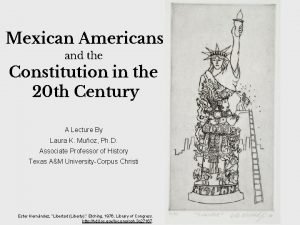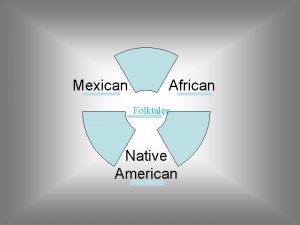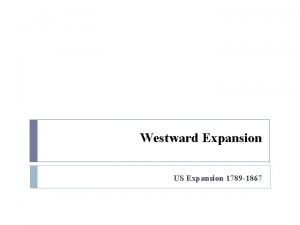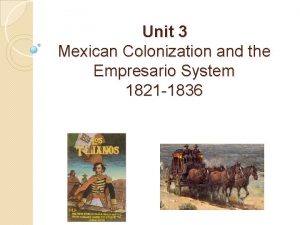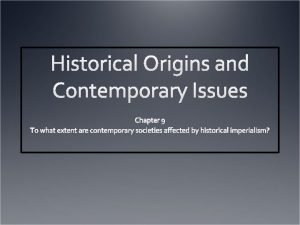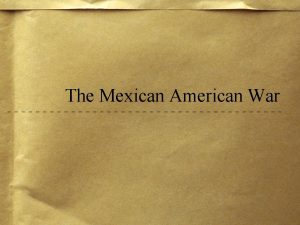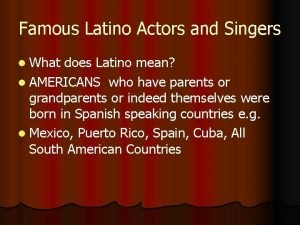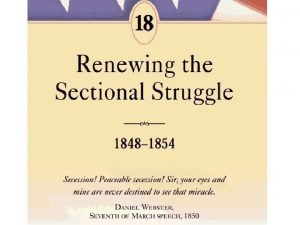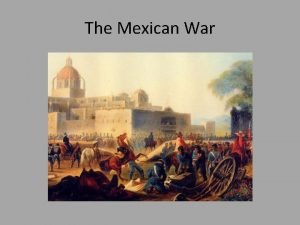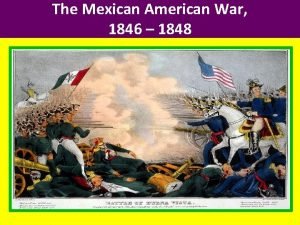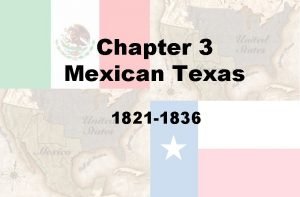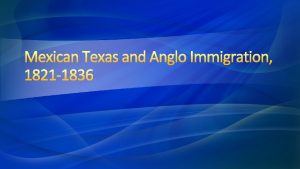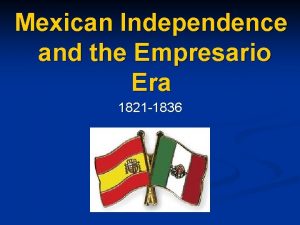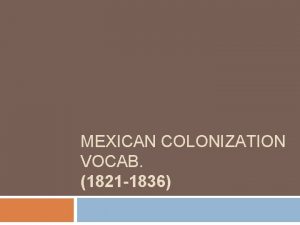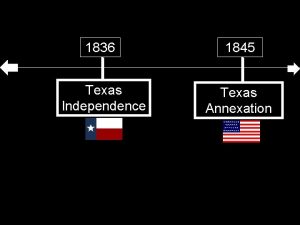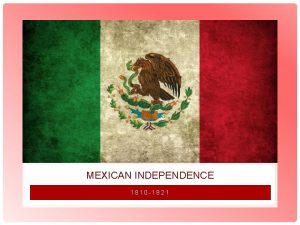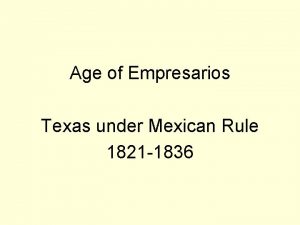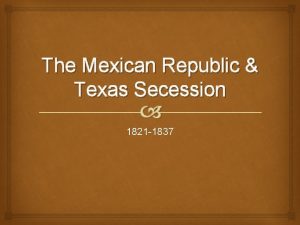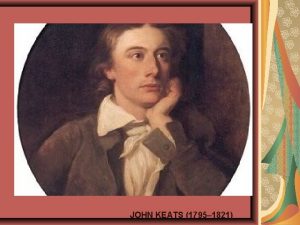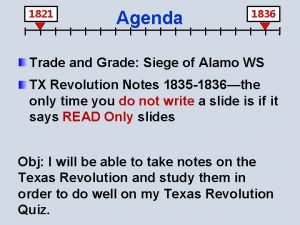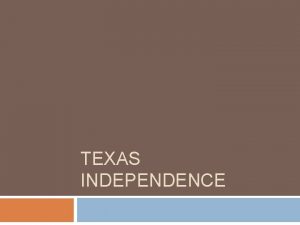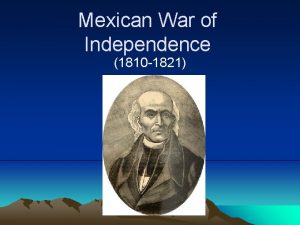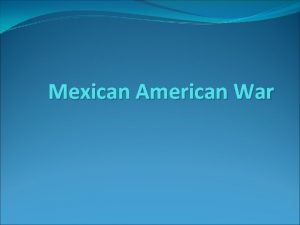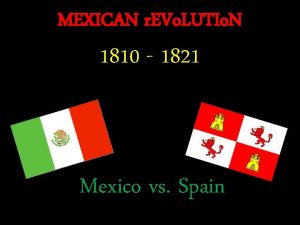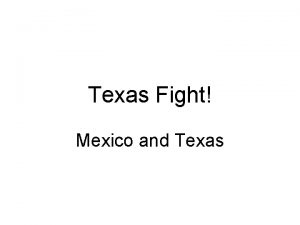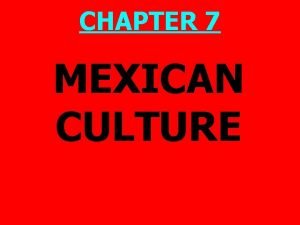Chapter 3 Mexican Texas 1821 1836 Map 1

















































- Slides: 49

Chapter 3 Mexican Texas 1821 -1836

Map 1) Borderlands 1700 -1763

Map 2) Borderlands 1763 -1800

Map 3) Borderlands 1800 -1819

Map 4) Borderlands 1819 -1848


Land Empresarios Moses Austin (1761 -`1821) In January 1821, the Spanish government agreed to Austin proposal to let him oversee the settlement of 300 Catholic families from the United States to Texas in exchange for a huge personal grant of Texas lands. (Calvert, De Leon, Cantrell, p. 58. ) After Moses’ death, his son, Stephen F. Austin, assumed his father’s contract. By 1825, Stephen Austin had nearly completed the terms of his first contract, and that year the government made a second agreement with him to settle 500 families. Stephen received an additional three grants between 1825 and 1831, but only complied fully with his first contract. He used part of his grants for speculating purposes, as did the other empresarios and even some settlers who sought to turn a profit from the Mexican government’s generosity. Between 1821 and 1835, a total of forty-one empresario contracts were signed, permitting some 13, 500 families to come to Texas. (Calvert, De Leon, Cantrell, pp. 58, 61 -62. )

Philip Nolan (1801) A scientific expedition dispatched by President Thomas Jefferson. (1806) General James Wilkinson (1806)

In 1819, Dr. James Long and a force of fellow filibusters attempted to wrest Texas from Mexico. This endeavor apparently had the backing of a group of Natchez entrepreneurs who were upset over the passage of the Transcontinental Treaty of 1819. p. 57.

The Constitution of 1824

Haden Edwards, Benjamin Edwards and the Fredonia Republic (1826)

The Investigation and Report of Mier Y Terán In order to evaluate how the national government might best deal with the troubles in Texas, Mexico dispatched Manuel de Mier y Terán, a high-ranking military officer and trained engineer, to the north. Crossing into Texas in 1828, Mier y Terán reported that: • The province was flooded with Anglo Americans • Nacogdoches had essentially become an American town • Prospects for assimilation of the Anglos into Mexican culture appeared dim • The Anglo settlements generally resisted obeying the colonization laws. Mier y Terán report spurred the drafting and implementation of the Law of April 6, 1830. Calvert, De Leon, Cantrell, p. 64. Manuel de Mier y Terán, 1789 -1832

The Law of April 6, 1830 • The Law of April 6, 1830 intended to stop further immigration into Texas from the United States by declaring uncompleted empresario agreements as void, although Mier y Terán let stand as valid those contract belonging to men who had already brought 100 families. • Future American immigrants must not settle in any territory bordering the United States. • New presidio were established to check illegal immigration. • The Law banned further importation of slaves into Texas. Calvert, De Leon, Cantrell, p. 64.

Among Anglos, a radical faction of the Federalists, which has come to be known as the “war party, ” emerged from the outrage over the Law of April 6. In the summer of 1832, friction between settler and authorities trying to enforce recently instituted policies regulating commerce in the Gulf ports and the collection of new tariffs reached a high pitch a the military post in Anahuac. Colonel Juan Davis Bradburn, The Law of April 6, 1830, Resisted an Anglo-American adventurer Calvert, De Leon, Cantrell, p. 64. who had joined the Centralist cause in Mexico, arrested the lawyer William Barret Travis when the latter attempted a ruse to secure the release of two runaway slaves that Bradburn had in protective custody. In response to Travis’s arrest, vigilantes gathered to call for his release. When Bradburn refused to surrender his prisoner, the colonists, accustomed to the Anglo-American tradition of the separation of military and civilian law, and to trial by jury, labeled Bradburn a despot.

Turtle Bayou Resolutions, 1832 In June of 1832, a party of Anglo Texas from around Anahuac and the port town of Brazoria marched on Bradburn’s garrison. A full-scale battle seemed imminent, but while waiting for reinforcements, the Anglos issued a document known as the Turtle Bayou Resolutions on June 13, 1832, which cleverly argued that their actions at Anahuac were not an uprising but a demand for their constitutional rights as Mexican citizens, adding that their cause was in sympathy to that of the Federalist leader, Antonio López de Santa Anna, then attempting to overthrow the Centrists, the party to which Bradburn belonged. Higher military officials avoided further bloodshed at Anahuac by replacing Bradburn and releasing Travis and other whom Bradburn had arrested. Calvert, De Leon, Cantrell, p. 64.

Anglos in Texas, 1821 -1836 • POPULATION: By 1834, it is estimated that the number of Anglo Americans and their slaves reached over 20, 700. This figure might well have represented the doubling of the number of Americans in Texas just sine 1830, which highlights the extent to which the Law of April 6, 1830 was disregarded, both by Anglos and sympathetic Spanish officials. • LIFE: Life in Texas was rough and rustic. Basic goods such as clothing, blankets, and footwear were not readily available. Many lived off the land, which involved hunting, fishing, planting small gardens and gathering nuts and berries. • COTTON AND SLAVERY: With slaves and imported technology, some Anglos planted and processed cotton for outside markets, and by 1834, Anglos’ farms may have shipped some 7, 000 bales of cotton to New Orleans. • BARTER AND SMUGGLING: Due to a lack of currency, people bartered to obtain needed commodities and services. Anglos found numerous ways to earn an income, among them smuggling. The tariff laws that exempted Anglo products during the 1820 s had not applied to all imports and generally excluded household goods and implements. Taking advantage of this loophole (even in cases where is was legally closed) Anglos brought merchandise illegally into Texas, and some even then shipped the products to more southern Mexican states or west to New Mexico. • EDUCATION: The foreigners established numerous schools in the 1820 s and 1830 s, patterning them after schools they had known in the southern United States. • RELIGION: Although Anglos had agreed to observe the Catholic religion in order to qualify as Mexican citizens, the Church neglected them because of, among other things, a shortage of priests. Hence, many Anglo settlers held illicit church services and religious camp meetings. (Calvert, De Leon, Cantrell, pp. 69 -71. )

Blacks in Texas, 1821 -1836 • Using the guise of contract labor, Anglos had been able to perpetuate slavery despite Mexican disapproval. By 1836, the number of slaves in Texas numbered about 5, 000. The institution of slavery arrived in Texas with all its southern trappings, for whites sought to recreate it just as it existed in the United States. As in the South, where society delineated strict roles for the different races, in Texas many Anglos considered blacks a racially inferior people suited to a life of strenuous labor and servitude. • Anglos considered slaves legal property. Hence slaves could be: • bought and sold • hired out • counted as one’s assets • used as collateral • Bequeathed • To control the slave population, whites followed tried and tested policies, including the liberal use of the lash. (Calvert, De Leon, Cantrell, pp. 71 -73. ) • Slaves attempted to run away when possible, often seeking refuge among the Indian tribes of East Texas or in the Mexican settlements of the nation’s interior.

Tejanos, 1821 -1836 • Most Hispanic Texans (Tejanos) lived in the ranching areas of Central and South Texas. Many of them were the descendants of the first colonizers and presidial soldiers assigned to garrisons through the Spanish period. • As was the case before Mexico gained independence, Mexican society in Texas continued to be a divided one, the emerging opportunities in commerce, ranching, and politics during the 1820 s and 1830 s fueling the fragmentation. Government bureaucrats, successful merchants or rancheros, and others who came from prominent families made up a small elite. Among its members were Erasmo and Juan N. Seguín, José Antonio Navarro, Ramón Músquis, and retired soldiers such as José Francisco Ruiz and José María Balmaceda. • The status of Hispanic women reflected both liberties and restrictions. Women sued for military survivors’ benefits and engaged in the sale of lands, from which some achieved financial standing equal to or surpassing that of some men. But women also suffered from serious disadvantages. Law and tradition barred them from voting or holding political office. Religion discouraged divorce, dooming many to endure unhappy marriages. There was also a double standard: women adulteresses were ostracized while a blind eye was turned to the philandering of men. • Hispanics supported education through fund-raising drives. Hispanics opened schools in the following communities: • Béxar • Laredo (1825) • Nacogdoches (1828) • Militia units remained the primary form of defense, as had been common during the period before 1821. (Calvert, De Leon, Cantrell, pp. 73 -74. ) • Catholicism remained the primary religion among the Mexican Texans.

Native Americans, 1821 -1836 • Those tribes that the Spanish had targeted for conversion had by the 1820 s either perished due to wars and (European) diseases, been displaced from their native lands and driving into the western regions, or had integrated successfully into Spanish/Mexican communities. • Only vestiges of the Coahuiltecans remained by the 1830 s • In 1824, setters from Austin’s colony launched hostilities against the Karankawas to drive them from their ancestral hunting lands. During the 1830 s, the Karankawas numbered less than 800 persons, but desperately clung to survival by preying on Tejano-owned cattle, or, in the case of those who gradually drifted back to their previous homeland, by “hiring out” to Anglo settlers as casual laborers or domestic servants. • The Plains Indians (Comanches, Apaches, and Norteños) remained faithful to their traditional lifestyles, relying on a combination of the hunt and small-scale farming. Women tended gardens, cultivating and harvesting corn, pumpkins, and beans, while the Plains warriors sabotaged settlements in an effort to halt the encroachment on their land to take livestock, especially horses. • The Caddos of East Texas contended with problems that threatened to unravel their civilization. Alcohol, provided to them by American traders, enfeebled many tribes people almost at the same time outsiders began penetrating long-held Caddo territory. Interlopers included other Native American peoples from the U. S. South as well as Anglo empresarios bearing contracts to establish colonies in Caddo land. By the late 1820 s, the Caddos numbered no more than 300 families. • In 1818 -1819, a band of Cherokees, bowing to legal and extralegal pressure by Anglos to abandon their homelands in Georgia and Alabama, arrived in northeastern Texas near Caddo land. They tried to settle near present-day Dallas, but were forced to relocate by the hostile Plains Indians. They eventually settled in and around today’s Van Zandt and Cherokee counties. The Cherokee actively sought to acquire legal title to their new homeland from the Mexican government, but never received anything but vague promises. (Calvert, De Leon, Cantrell, pp. 73 -74. )

THE QUIET SUFFERING AND MISERY OF WAR: The Wars for Independence left Mexico in disorder and decay. Conditions were far worse in Mexico than in Argentina or Brazil because the actual fighting had been so much more widespread and protracted in Mexico. The economy was in shambles. Spaniards and taken their capital out of the country. Of a population of seven million, an estimated half a million died during the war years. Devastation in the countryside and in the cities left thousands unemployed. Disease, banditry, and violence were rampant. (Skidmore & Smith, p. 254; Suchlicki, p. 61) Agricultural production was at a standstill, because many farms and haciendas had been destroyed and abandoned. (Suchlicki, p. 61)

The textile industry had fallen on hard times. The scars of battle were visible throughout the country, especially in the central valley. As one traveler recalled, there were “ruins everywhere—here a viceroy’s place serving as a tavern, where the mules stop to rest, and the drivers to drink pulque—there, a whole village crumbling to pieces; roofless houses, broken down walls and arches, and old church—the remains of a convent. ” (Skidmore & Smith, p. 255. )

RESTLESS UNEMPLOYED SOLDIERS: Economic disorder meant there were very few jobs and much unemployment According to one estimate, about 300, 000 men, most of whom had fought in the wars, had no job or income when the battles came to an end. This represented 15 to 30 percent of the entire adult male population. They were eager, often angry, and usually armed. They posed not only an economic problem but a social threat as well. (Skidmore & Smith, p. 255. )

The two institutional bases of power in Mexico after independence: The Church The Military

President Guadalupe Victoria Vice-President Nicolás Bravo Liberals wanted: Conservatives wanted: • the state to guide the Church, instead • a strong Church which would play an of the other way around important role in guiding the nation • a decentralized, federal republic • a strong central government that • limited democracy (but more inclusive guarded against the passions of the than any conservative wanted) masses and the dominance of local • individual property rights as opposed interests to communal property rights • to support corporate ownership in • the abolition of fueros, or special mining and industry privileges of corporate entities (i. e. the • protection for Church and military Church and the army) fueros • secular education • Catholic education

The Presidential Election of 1828 1. Manuel Gómez Pedraza wins. 2. The liberals could not accept the outcome, and started a revolution with Santa Anna as their military leader. 3. The Revolution is successful, and the insurgents install their candidate, Vicente Guerrero, as president. Anastasio Bustamante, a compromise conservative, became vice-president.

The Spanish Invasion of 1829 1. The Spanish invade Mexico and take Tampico in July of 1829. 2. Santa Anna lays siege on their fort, and the Spaniards, plagued by yellow fever and lack of provisions, surrender by October. 3. Many Spanish merchants leave Mexico to escape reprisals by angry Mexican nationals. General Santa Anna

A Parade of Coups d'état 1. Guerrero refused to relinquish the extraordinary "emergency" powers that Congress had given him to cope threat posed by the Spanish invasion. 2. In reaction against this, Vice-President Bustamante posed as a champion of constitutionalism and led an armed revolt against Guerrero's government. For the second time in Mexico's brief history a conservative vice-president led an armed revolt against a liberal president. But where Nicolás Bravo had failed, Bustamante, largely because of his influence with the army, succeeded. 4. Bustamanta captured President Guerrero, and had him executed on January 14, 1831. 5. The Repression of the Bustamante dictatorship: Bustamante soon became a rather crude dictator. (suppression of the press, badgering the legislature and judicial branches, political corruption, repression against the Yorquinos {Liberal Free Masons}). 6. Santa Anna overthrows Bustamante. In response to his General Santa Anna took up the liberal cause and marshaled his forces to overthrow the Bustamante government. Bustamanta's government soon fell to Santa Anna, who then returned to Veracruz to revel in his latest victory and await the outcome of the 1833 presidential elections.

The following era, from roughly 1833 to 1855, can be justifiably termed the era of Santa Anna. He dominated Mexican politics for much of this period, and left an indelible mark on Mexican history. General Antonio Lopez de Santa Anna Born in Veracruz in 1794, the young Santa Anna showed little interest in books. Instead, at the age of sixteen he joined the army and soon thereafter fought against pro. Hidalgo rebels. For the next decade, the young Calvary officer staunchly supported the crown's efforts in New Spain.

General Antonio Lopez de Santa Anna

The era of Santa Anna: An era of flamboyant caudillaje and chronic instability 1821 --he switched allegiance and joined Iturbide's fight for Mexican Independence. 1823 --he led republican forces against the empire and was instrumental in overthrowing Iturbide. 1827 --he took the lead in suppressing Vice-President Nicolás Bravo's (conservative) revolt against President Victoria (liberal). 1828 --he saw to it that the defeated liberal candidate, Vicente Guerrero, was installed in office. 1829 --he defeated the Spanish invasion forces as Tampico to save the infant republic. 1832 --he overthrew the Bustamante dictatorship after it had become intolerable. But his illustrious career in a chaotic Mexico was just getting started in 1833. Indeed--if you can believe it--1833 marks the beginning of an era that was even more chaotic for Mexico. Between May 1833 and August 1855 the presidency changed hands thirty-six times, the average term being about 7½ months. Santa Anna occupied the presidential chair on eleven different occasions, and, without question, he was the most powerful political figure in Mexico during this time. Even when he was out of office he was a powerful force to be reckoned with and a constant danger to the incumbent regime and to anyone aspiring to the succession.

Santa Anna wins the Presidency in 1833, then leaves it to Gómez Farías In 1833, Santa Anna won the presidency with the largest majority in Mexican history. But, he soon grew bored of the presidential day-to-day work. Thus, he returned to his estate in Vera Cruz and left the presidency to Vice. President Valentín Gómez Farías.

The liberal reforms of Valentín Gómez Farías A. Military Reforms: 1. Reduce the size of the army 2. He abolished military fueros (i. e. army officers would now have to stand trial in civil courts. )

B. Gómez Farías’s Clerical Reforms 1. Clergymen throughout the country were advised that they should limit their directives and admonitions from the pulpit to matters of religion. 2. The secularization of education--including the University of Mexico. 3. All future clerical appointments would be made by the government rather than the papacy. 4. The mandatory payment of the tithe was declared illegal. (The individual was asked to search his own conscience and respond as he would. ) 5. Congress enacted legislation permitting nuns, priests, and lay brothers, who had taken oaths to spend their entire lives as brides and servants of Christ, to forswear their vows. (This was done in the name of individual freedom--a concept much in vogue with the nineteenth-century liberals. ) 6. The Franciscan missions in California were secularized and their funds and property sequestered.

Understandably, many of those who had vested interests in the Church or the military hated Gómez Farías reforms. To the rallying cry of Religión y Fueros the church, the army, and other conservative groupings banded together and called for the overthrow of the government. Santa Anna joins the conservatives cause and overthrows the government of his former Vice-President, Gómez Farías: Again thirsting for public acclaim the retired President Santa Anna jumped at the new opportunity for action and agreed to lead the movement against his former vice-president, Gómez Farías. Not embarrassed by lack of consistency, the embattled champion of all liberal causes since 1821 suddenly began denouncing anticlerical atheists, naive federalists, subversive anarchists, Gómez Farías, and his liberal cohorts.

The Constitution of 1824

The Texas Revolt A. Permission to settle: Starting in 1821, Spain and then an Independent Mexico had granted permission to Catholic (North) Americans to settle the sparsely populated territory of Texas. B. Incentives for settlement: Soon there was a great influx of Americans settlers into Texas. The land was practically free--only 10¢ an acre as opposed to $1. 25 an acre for inferior land in the U. S. Each male colonists over twenty-one years of age was allowed to purchase 640 acres for himself, 320 acres for his wife, 160 acres for each child and, significantly, an additional 80 acres for each slaves that he brought with him. The numerical dominance of the American settlers: 1827: By 1827 there were some 12, 000 United States citizens living in Texas, while there were only 7, 000 Mexicans. 1835: By 1835 the immigrant population had reached 30, 000, while the Mexican population had barely passed 7, 800

The Mexican response to the influx of Americans 1. Slavery was abolished: The first important piece of legislation designed to prevent a further weakening of Mexican control was President Guerrero's emancipation proclamation of 1829. Because slavery as not important anywhere else in the republic, the measure was clearly directed at Texas. Although manumission was not immediately enforced, it was hoped that the decree itself would make Mexico less attractive to colonists from the U. S. South and would thus arrest immigration. 2. Forbiddance of further immigration: The colonization law of 1830 explicitly forbade all future immigration into Texas from the United States and called for the strengthening of Mexican garrisons, the improvement of economic ties between Texas and the remainder of Mexico by the establishment of a new coastal trade, and the encouragement of increased Mexican colonization.

October 2, 1835—The Battle of Gonzales. The first battle of the Texas Revolution begins when Santa Anna sends a detachment of Mexican Calvary to retrieve a cannon. Texans drive them back using the cannon. The battle flag used by the Texans features a picture of a cannon and the written dare "come and take it. "

The Texans Response The Texans considered these measures repressive. The last straw, as far as the Texans were concerned, was the news from Mexico City that Santa Anna had arbitrarily annulled the federal Constitution of 1824. The centralist tendencies of the new regime meant that, instead of having a greater voice in the management of local affairs, the Texans were to have no voice at all. The Lone Stare Republic is declared. The Texans had decided on independence and subsequently chose David Burnet as president of the Lone Star Republic and Zavala as vice-president.

* 1835: Santa Anna moves north at the head of some 6, 000 troops. * In 1836 a Mexican force of about 4000 men commanded by Santa Anna reached San Antonio. The San Antonio garrison— 187 men under the command of Colonel William Barrett Travis— withdrew to the Alamo. About 15 civilians were with the men inside the Alamo. Santa Anna attacked the Alamo, eventually breaching the mission walls. Only the civilians survived.


The Goliad Affair: Mexican forces executed 365 Texan prisoners who had surrendered. Several weeks after the surrender of the Alamo, Genaral José Urrea engaged a force of Texans under the command of Colonel James W. Fannin at the small town of Goliad. Surrounded and outnumbered, Fannin surrendered in the belief that he and his men would be afforded the recognized rights of prisoners of war. Realizing that the tenor of the war had been set at the Alamo, General Urrea wrote to Santa Anna urging clemency for Fannin and the other prisoners. Urrea then moved on to another engagement and left the Texas prisoners in the charge of Lieutenant Colonel Nicolás de la Portilla. Santa Anna, however, ordered Nicolás de la Portilla to execute the prisoners, which he promptly did despite some moral misgiving. All 365 prisoners were executed.

The Houston administration also passed legislation to encourage immigration and raise revenue; for this it turned to land, the government’s most tangible resource. The ad interim government had provided headrights (grants of land that obliged grantees to comply with certain conditions, such as improving the land) in order to entice volunteers into the Texas army. (p. 90. ) Texas Forever!! [New Orleans? 1836]. Broadside, CN 00834, Broadside Collection. This is the only known copy of an inflammatory circular issued in New Orleans that demonized the Mexican army and offered substantial inducements of land to all who would come to aid the Texan cause. The broadside contains a brief account of the Alamo siege, the outcome of which was still unknown at the time this circular was issued.

Battle of San Jacinto

Santa Anna is defeated and captured at the Battle of San Jacinto: The excesses committed by Santa Anna's troops at the Alamo and Goliad crystallized opposition to Mexico both among Texans and in the United States. Supplies and men began to pour into Texas, and by the third week in April Houston felt strong enough to make a stand. He chose his own ground and, in the middle of the afternoon on April 21, caught Santa Anna's troops of guard near San Jacinto River. Within half an hour the Mexican arm was routed, and Santa Anna himself fled for safety. Two days later he was captured by one of Houston's patrols.

In this popular print the victorious General Houston, dressed in colorful Indian garb, vents his moral wrath on the defeated Mexican commanders. The contemporary lithograph suggests how deeply the events of the Texas Revolution resonated in the United States.

Mexico: Territorial Divisions, 1820 s


The loss of Texas and the war with the United States contributed more to Mexico’s impoverishment, its apparent sterility, its xenophobia, its lack of self-esteem, and its general demoralization than any other event of the nineteenth century. (Meyer, Sherman and Deeds, p. 317)
 What did mier y teran observe in texas
What did mier y teran observe in texas Us map 1821
Us map 1821 Why did settlers in texas rebel against mexican rule?
Why did settlers in texas rebel against mexican rule? 1836-1809
1836-1809 1769 - 1821
1769 - 1821 Dissatisfaction (1835-56)
Dissatisfaction (1835-56) Nikolai gogol 1836
Nikolai gogol 1836 Arrieros 1836 carl nebel
Arrieros 1836 carl nebel K
K Election of 1836 & rise of mass democracy
Election of 1836 & rise of mass democracy Adler v george golden rule
Adler v george golden rule Intrinsic aids examples
Intrinsic aids examples Napoleontiden
Napoleontiden Naples revolution 1821
Naples revolution 1821 1821-1769
1821-1769 Fjodor mihajlovics dosztojevszkij gyermekek
Fjodor mihajlovics dosztojevszkij gyermekek Manifest destiny
Manifest destiny Escarpment definition geography
Escarpment definition geography Florida cession prior owner of territory
Florida cession prior owner of territory British cession 1818
British cession 1818 A mexican jumping bean jumps with the aid
A mexican jumping bean jumps with the aid Mexican independence from spain timeline
Mexican independence from spain timeline Mexican american war comic
Mexican american war comic Chicano literature short stories
Chicano literature short stories Dgn mexico
Dgn mexico Larry hoover net worth
Larry hoover net worth Effects of the mexican-american war
Effects of the mexican-american war Effects of the mexican-american war
Effects of the mexican-american war What were the causes of the mexican revolution
What were the causes of the mexican revolution Mexican cession apush
Mexican cession apush Mexican independence from spain timeline
Mexican independence from spain timeline Which country is texas
Which country is texas Pakistani mexican wedding
Pakistani mexican wedding Mexican airspace
Mexican airspace Mexican foosball table
Mexican foosball table Mexican basketry
Mexican basketry Edgewood isd v kirby definition
Edgewood isd v kirby definition Mexican fables
Mexican fables Pymetec
Pymetec Mexican cession date acquired
Mexican cession date acquired What role did erasmo seguin and jose antonio navarro
What role did erasmo seguin and jose antonio navarro Mexican constitution of 1824
Mexican constitution of 1824 Austin
Austin Mexican crops
Mexican crops Rxrelief pharmacy discount card
Rxrelief pharmacy discount card Mexican american war begins
Mexican american war begins Famous hispanic singers and actors
Famous hispanic singers and actors Popular sovereignty in the mexican cession
Popular sovereignty in the mexican cession Mexican cession
Mexican cession Mexican american war
Mexican american war
